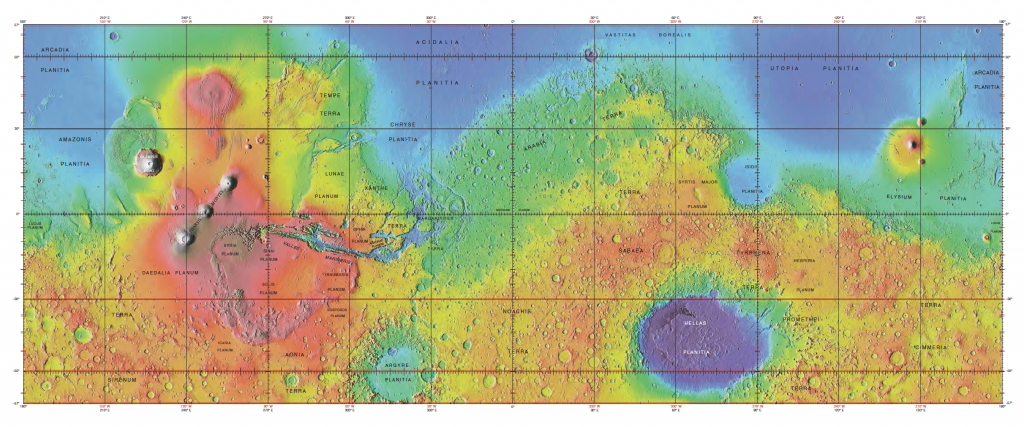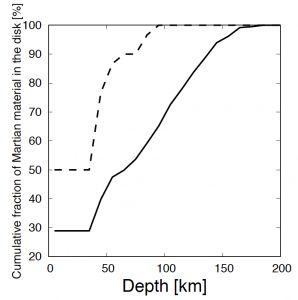Editor’s note: Astrobites is a graduate-student-run organization that digests astrophysical literature for undergraduate students. As part of the partnership between the AAS and astrobites, we repost astrobites content here at AAS Nova once a week. We hope you enjoy this post from astrobites; the original can be viewed at astrobites.org!
Title: On the Impact Origin of Phobos and Deimos I: Thermodynamic and Physical Aspects
Author: Ryuki Hyodo, Hidenori Genda, Sébastien Charnoz, and Pascal Rosenblatt
First Author’s Institution: Tokyo Institute of Technology, Japan
Status: Accepted to ApJ, open access
Where Did Phobos and Deimos Come From?
Phobos and Deimos, Mars’ two small moons, were initially believed to be the result of interplanetary kidnapping. Many moons in our solar system appear to be captured objects, and the featureless reflectance spectra of Phobos and Deimos hint that they might be D-type asteroids. However, captured objects tend to have highly eccentric orbits, and both Phobos and Deimos orbit Mars in a nearly circular fashion. More recently, it has been proposed that both moons are the result of a massive impact 4.3 billion years ago — instead of having been captured from interplanetary space, they could have coalesced from the debris disk generated by the impact. Past research has shown that the masses and orbits of Phobos and Deimos can be explained by this method. This theory could also explain the presence of Borealis basin, an extended low-altitude region spanning Mars’ north pole, which can be seen in Figure 1.

Figure 1. Topographical map of Mars. Borealis basin is the low-lying (blue) region in the northern hemisphere. It encompasses many officially-named regions, such as Vastitas Borealis and Utopia Planitia. [Adapted from this image, which is made from data from the Mars Orbiter Laser Altimeter aboard Mars Global Surveyor]
Building Baby Moons
To generate a debris disk, the authors modeled a collision between young Mars and an impactor with 3% the mass of Mars. The first 20 hours of their simulation are shown in Figure 2.

Figure 2. Snapshots from the first 20 hours after the simulated impact. Top row: Positions of particles over time. Red points are Mars particles, yellow are particles that fall on to Mars, white are disk particles, and cyan are particles that escape the system. Bottom row: Temperature of the particles. Shock heating in the moments after impact liquefies much of the material. [Hyodo et al. 2017]

Figure 3. The cumulative fraction of Mars-originating disk particles as a function of the depth below Mars’ surface from which they originated. Beyond 4 Mars radii (solid line), there is a higher percentage of particles originating from > 50 km below the surface than in the disk as a whole (dashed line). [Hyodo et al. 2017]
Know Before You Go: How Can This Help Future Mars Missions?
Now that we have some idea what to expect if Phobos and Deimos were formed from a debris disk, how can we use this knowledge? These results will be valuable for the planning of future Mars-system sample-return missions, like JAXA’s planned Martian Moon eXploration (MMX) mission, which is set to launch in the early 2020s. MMX is slated to make close observations of both Phobos and Deimos before collecting a sample from one of the moons and returning it to Earth. Performing simulations like these in advance of future sample return missions will help scientists interpret their findings to learn about the origin of these two moons as well as the interior of Mars itself.
About the author, Kerrin Hensley:
I am a third year graduate student at Boston University, where I study the upper atmospheres and ionospheres of Venus and Mars. I’m especially interested in how the ionospheres of these planets change as the Sun proceeds through its solar activity cycle and what this can tell us about the ionospheres of planets around other stars. Outside of grad school, you can find me rock climbing, drawing, or exploring Boston.


2 Comments
Pingback: What Are Mars’ Moons Made Of? – MeasurementDataBases for Industry & Science
Pingback: Astronomy News